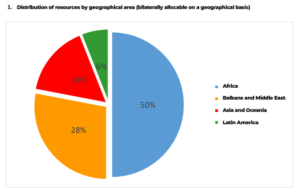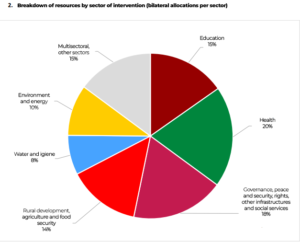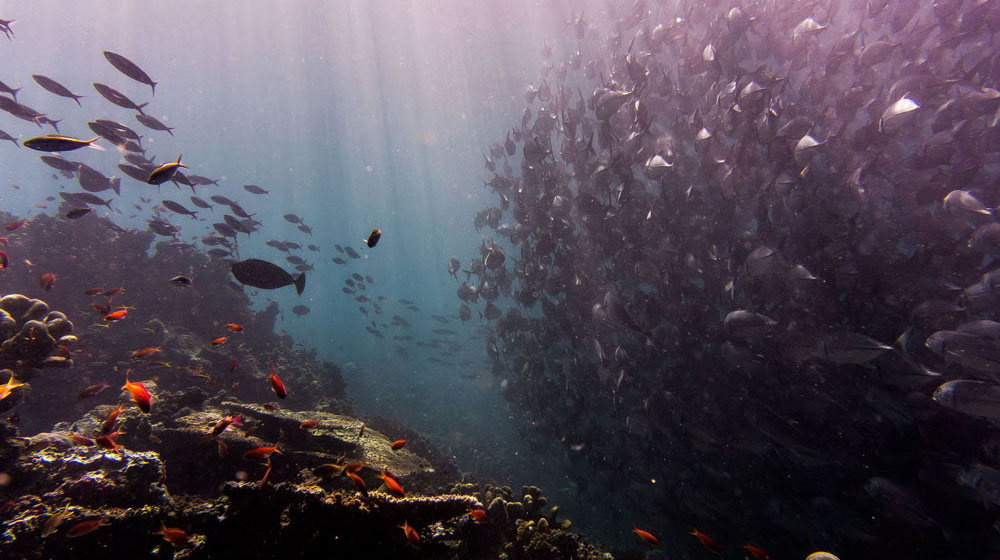International Cooperation is a set of practices to support the development of the least developed countries, is implemented through differentiated practices. The areas of intervention of projects are many and varied, ranging from social and health aid to the protection of human rights, from food security and rural development to basic education and vocational training, from support for information and democratisation programmes to the promotion of the territory and cultural heritage of developing countries.
International cooperation can be bilateral, multilateral, decentralised or non-governmental. Those who carry out cooperation and development aid initiatives and projects are governments and local authorities, international organisations such as the United Nations, the World Bank, the FAO, non-governmental organisations and other actors such as international solidarity associations, fair trade organisations, private social organisations and cooperatives.
Cover photo © Lightspring/Shutterstock.com


Who meets the 0.70% threshold
In 2021, the OECD DAC countries (see Focus 2) invested $185 billion in development cooperation. This is an increase compared to 2020, but only in absolute terms. According to Italian research website Openpolis.it, a comparison of this amount with the total GNI of these countries shows an ODA/GNI ratio of 0.33%, the same as last year and far from the 0.70% target.
The European countries of the DAC group performed better, reaching 0.50% ODA/GNI. In fact, only five countries in the world (Luxembourg, Norway, Sweden, Germany, Denmark) have already reached the 0.70% target and are European.
In 2021, the top ten ODA donors in terms of national wealth were Luxembourg, Norway, Sweden, Germany, Denmark, the Netherlands, France, the UK, Switzerland and Finland. However, the picture changes significantly if we look at absolute values instead of amounts in relation to national wealth. In this case, for example, the United States, which is at the bottom of the league table in relative terms, comes out on top: with USD 47.8 billion, the USA provides almost 26% of all ODA to the DAC countries. In absolute terms, the top ten donors are the US, Germany, Japan, the UK, France, Canada, Italy, Sweden, the Netherlands and Norway.

The case of Italy
Italy ranks 16th among donors in 2021. Unfortunately, Italy is one of the donors that is not only still below the 0.70% threshold. At 0.29%, it is also far from the target. The most worrying aspect of the Italian data, however, is its unstable trend over the years.
According to Openpolis’ results, after a significant increase between 2014 and 2017, Italy’s Aps/Rnl ratio fell dramatically in the following two years. 2021 was then a new year of growth, but it is not clear whether this can be considered stable or episodic in nature. The resources allocated through the multilateral channel (i.e. the resources allocated by a donor country to multilateral development organisations) have grown steadily over the years because they are linked to mandatory funding commitments to international organisations of which Italy is a member. On the other hand, those allocated through the bilateral channel (i.e. funds managed directly by the donor) have historically been discontinuous.
This is, according to the analysis, “a sign of the absence of a stable policy capable of multiannual programming”. Indeed, despite the provisions of Law L.125/2014 on the General Discipline on International Cooperation for Development, Italy has ‘never managed to make development cooperation an integral and qualified part of Italian foreign policy’. For the three-year period 2021-2023, the resources earmarked in the 2021 budget law amount to €1,709.6 million.
According to the Three-Year Planning and Policy Document 2021-2023, the priority countries for Italian cooperation are Ethiopia, Kenya, Somalia, Sudan, Burkina Faso, Mali (*), Niger, Senegal, Mozambique in Sub-Saharan Africa, Egypt and Tunisia in the Mediterranean, Jordan, Iraq, Lebanon, the Palestinian Territories in the Middle East, Albania in the Balkans, Cuba, El Salvador for Latin America and the Caribbean and Afghanistan, Myanmar for Asia.
Who does what
The 070 Campaign
A number of Italian organisations involved in international cooperation (Focsiv, AOI, CINI and Link 2007, under the patronage of ASVis, Caritas Italiana, Forum Nazionale del Terzo Settore and MISSIO) have promoted the campaign “The world is hungry. For development”. The campaign has two objectives: “to use the best skills of our organisations to relaunch development cooperation, also in terms of resources, to share experiences and proposals in order to raise awareness among the widest possible public and to mobilise new resources, especially for Italian bilateral cooperation, which is particularly affected by the reduction in aid volumes”.
The Campaign supports the introduction in Italian legislation of a precise pathway to reach the 0.70% ODA target by 2030, in the interest of Italy as a key player in the implementation of the Sustainable Development Agenda.
“We cannot wait until 2030”, they write, “to ensure the achievement of the 0.70% target for international solidarity: in order to tackle today’s problems with a sense of responsibility, resources must be available in the short term.
FOCUS 1
The 0.70% threshold and the 2030 Agenda
As far back as 1970, member countries of the OECD’s Development Assistance Committee (DAC, see Focus 2) pledged to spend 0.70% of their gross national income (GNI) on official development assistance (ODA). However, this commitment was not met and was therefore reaffirmed by the United Nations in 2015 by including it in the 2030 Agenda for Sustainable Development. According to target 17.2, donor countries should reach 0.70% ODA/GNI by 2030.
In addition, the 2030 Agenda stipulates that the least developed countries (LDCs) should reach between 0.15 and 0.20 per cent ODA/GNI. This commitment was made in 2011 with the Programme of Action for LDCs, and even earlier in 1981 at the UN Paris Conference.
FOCUS 2
Development assistance and the DAC
The Development Assistance Committee (DAC) operates within the OECD. The purpose of the Committee is to steer development cooperation policies by identifying common principles and defining guidelines and standards for interventions. The member countries of the DAC are the largest donors, providing 65% of global development aid. 26% of aid comes from multilateral agencies and only 9% from non-member countries. However, compared to the gross national income of the member countries, the DAC reaches 0.31 aps/rnl.
In 2017, member countries allocated $147 billion in APS, a decrease of 0.1 per cent in real terms from 2016. Despite the renewed UN targets in the 2030 Agenda, the aps/rnl ratio of DAC countries has not increased significantly in recent years. As of 2023, 32 countries are members of the DAC (Australia, Austria, Belgium, Canada, the Czech Republic, Denmark, the European Union, Estonia, Finland, France, Germany, Greece, Hungary, Iceland, Ireland, Italy, Japan, Korea, Lithuania, Luxembourg, the Netherlands, New Zealand, Norway, Poland, Portugal, the Slovak Republic, Slovenia, Spain, Sweden, Switzerland, the United Kingdom and the United States). There are seven countries that participate but are not official members: Azerbaijan, Bulgaria, Kuwait, Qatar, Romania, Saudi Arabia and the United Arab Emirates. Observers are the Asian Development Bank, the African Development Bank, the Inter-American Development Bank, the International Monetary Fund, the United Nations Development Programme and the World Bank.



















